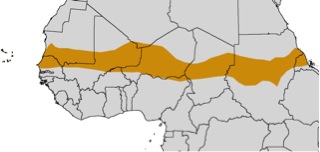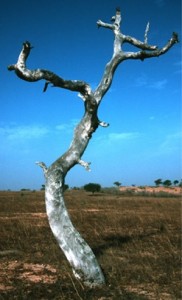Communities in the Sahel region of Africa depend on trees for firewood, food, building materials, and even medicine. Anecdotal observations in this savannah climate, a transition region to the south of the Sahara Desert, have suggested the number of trees is decreasing. A recent study by a group of researchers at the University of California at Berkeley has provided scientific support indicating that trees are indeed dying and the decline is being attributed to climate change. Scientists looked at aerial photos dating back to 1954, satellite images, climate change records, and actually walked around the Sahel on foot to measure and count trees.
The Scientists found that the average temperature in the Sahel warmed by 0.8 degrees Celsius and rainfall decreased by as much as 48% between 1954 and 2002. Due to the hotter, drier climate the trees started dying – one out of every six trees present in 1954 died by 2002. And, not only did specific trees die, but whole species actually disappeared from this region; as much as one in five tree species were no longer present by 2002. Fruit and timber trees, which require a lot of moisture and also are very important to local populations, were impacted the most. In general, the scientists found that climate change is causing vegetation zones to shift, moving toward areas with more moisture.
One of the Intensive Observing Periods (IOPs) of the Student Climate Research Campaign (SCRC) is the Climate and Land Cover project. During this campaign, students take photographs throughout the year and classify land cover areas (check out the land cover protocol) near their schools and upload these data to the GLOBE database. These kinds of photographs are exactly the kind of data scientists need to study how land cover changes over time, including to monitor the presence of trees in various regions around the world. GLOBE students can contribute to the database by participating in these IOPs, and help study trends in their local landscape and vegetation over time.
Have you heard stories (anecdotes) about land cover changing due to climate change near your school or home? If so, send us an email or add a comment to let us know! And, don’t forget to take part in the Climate and Land Cover IOPs!
-JSM



Such adorable post… Thanks for sharring its spreading lots of positivity…
I never thought about it this way. It opens my eyes for another problem we have in climate change in Africa. God, we have to work faster otherwise our whole planet will have a hugh problem
Is the area that is becoming unsuitable to growing trees actually growing or is it simply shifting? I read somewhere that there is the idea that the sahara is not necessarely growing, but it tends to move north and south over time.
I would have to agree with the comments offered by the last poster. I read a similar article regarding the Sahara. These shifts in deserts and even to some degree in forests are normal.
General climate change, shortening of wood supply has already reached market – rosewood, ebony and pernambuco are becoming expensive and rare